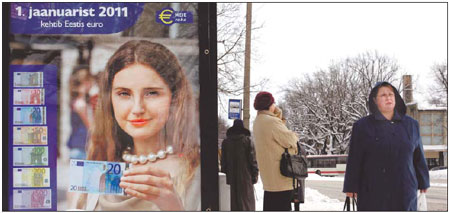Estonia adopts euro as of Jan 1
|
A woman carries shopping bags as she passes a poster informing people about the adoption of the Euro in Parnu on Tuesday. Estonia will join the eurozone on January 1. Ints Kalnins / Reuters |
BRUSELLS - Estonians will replace their currency, the kroon, with the euro beginning Jan 1 with both joy and hesitation, as Europe's public debt turmoil is more likely to engulf more countries after the crises in Greece and Ireland.
With a population of 1.34 million, Estonia will become the eurozone's 17th member since the euro currency was put into circulation in 2002. Estonia joined the European Union, which has 27 members, on May 1, 2004.
Estonia is busy preparing an evening concert and fireworks in its capital Tallinn on New Year's Eve to celebrate the euro introduction.
"This marked the beginning of our journey toward the developed world," Estonian President Toomas Hendrik Ilves told AFP.
"Estonia has since become a member of the EU and NATO, in 2004, and joining the eurozone in January 2011 will mean arriving in Europe again," the president said.
However, the local media has reported that optimism among Estonia's consumers has slipped in recent months - most likely due to uncertainty surrounding the country's upcoming accession to the eurozone.
Estonia is the third EU member in Eastern Europe that has introduced the euro. Slovenia became the first eurozone Eastern European member in 2007, followed by the Slovak Republic in 2009.
Latvia and Lithuania, meanwhile, have been in efforts to meet fiscal, debt and inflationary requirements to join the euro club as they seek to adopt the euro in 2014.
As opposed to the confidence in Latvia and Lithuania, other nations are more wary and hesitant as the currency is in turmoil and most of euro member countries so far haven't met the strict requirements of using the euro.
AFP has reported, for instance, that Poland is cautious - while the Czech Republic remains downright skeptical.
Under the 1992 Maastricht Treaty that created the European economic and monetary union, countries must meet certain conditions in order to adopt the euro.
The government budget deficit, for example, must not exceed 3 percent of GDP, and the government debt must be below 60 percent of the GDP.
The inflation rate of the state, meanwhile, must not exceed the average inflation rate of the three best-performing member states by more than 1.5 percentage points.
Inflation foiled Estonia's first attempt to switch to the currency in 2007, as the economy overheated - but it fell below the hurdle as demand withered and commodity prices slumped.
Estonia fulfilled the exchange-rate stability criterion because its kroon - created in 1992 to replace the Soviet ruble, a year after independence from Moscow - has been pegged tightly from the outset.
The kroon was hooked to the newborn euro in 2002 at a rate of 15.6466 to one euro, and the rate has not changed since. For the previous 10 years, it had likewise been anchored solidly to the Deutschmark.
"The year 2010 was dominated by the public debt crises in the eurozone," Herman Van Rompuy, president of the European Council, said recently, adding that stabilizing the euro is in the interests of all member countries as Estonia becomes the club's 17th member.
Van Rompuy noted that the EU has made an impressive series of decisions to establish new forms of macro-economic surveillance, grant conditional emergency loans to two countries in difficulties, Greece and Ireland, and establish a permanent mechanism to deal with such crises from mid-2013.
"These decisions constitute the biggest reform of the Economic and Monetary Union since the euro was created," said Van Rompuy.
China Daily
(China Daily 12/30/2010 page12)















